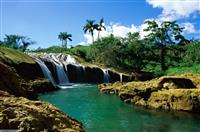
我现在常常“解剖”摘要。几个星期前,我发现有一篇没有“被修理”过的摘要。
This is an unedited manuscript that has been accepted for publication. Nature Research are providing this early version of the manuscript as a service to our customers. The manuscript will undergo copyediting, typesetting and a proof review before it is published in its final form. Please note that during the production process errors may be discovered which could affect the content, and all legal disclaimers apply.
于是,我复制了原文。等了好久,“正文”终于出场了!我把正文加黑了。
Managing nitrogen to restore water quality in China
https://www.nature.com/articles/s41586-019-1001-1
[1] The nitrogen cycle has been radically changed by human activities1.
Copy edited: (same)
[2] China consumes nearly a third of the world’s nitrogen fertilizers.
China consumes nearly one third of the world’s nitrogen fertilizers.
[3] The excessive application of fertilizers2,3 and increased nitrogen discharge from livestock, domestic and industrial sources have resulted in pervasive water pollution.
(same)
[4] Quantifying a nitrogen ‘boundary’4 in heterogeneous environments is important for effectively managing local water quality.
Quantifying a nitrogen ‘boundary’4 in heterogeneous environments is important for the effective management of local water quality.
[5] Here we use a combination of water quality observations and simulated nitrogen discharge from agricultural and other sources to estimate spatial patterns of nitrogen discharge into water bodies across China from 1955 to 2014.
Here we use a combination of water-quality observations and simulated nitrogen discharge from agricultural and other sources to estimate spatial patterns of nitrogen discharge into water bodies across China from 1955 to 2014.
[6] We find that the critical surface-water quality standard (1.0 milligrams of nitrogen per litre) was being exceeded in most provinces by the mid-1980s, and that current rates of anthropogenic nitrogen discharge (14.5 ± 3.1 megatonnes of nitrogen per year) to fresh water are about 2.7 times the estimated ‘safe’ nitrogen discharge threshold (5.2 ± 0.7 megatonnes of nitrogen per year).
(same)
[7] Current efforts to reduce pollution through wastewater treatment and improving cropland nitrogen management can partially remedy this situation.
(same)
[8] Domestic waste water treatment has helped to reduce net discharge by 0.7 ± 0.1 megatonnes in 2014, but at high monetary and energy costs.
Domestic wastewater treatment has helped to reduce net discharge by 0.7 ± 0.1 megatonnes in 2014, but at high monetary and energy costs.
[9] Improved cropland nitrogen management could remove another 2.3 ± 0.3 megatonnes of nitrogen per year, about 25 per cent of the excess discharge to fresh water.
Improved cropland nitrogen management could remove another 2.3 ± 0.3 megatonnes of nitrogen per year—about 25 per cent of the excess discharge to fresh water.
[10] Successfully restoring a clean water environment in China will further require transformational changes to boost the national nutrient recycling rate from its current average of 36 per cent to about 87 per cent, which is a level typical of traditional Chinese agriculture.
(same)
[11] Though ambitious, such a high level of nitrogen recycling is technologically achievable at an estimated capital cost of approximately 100 billion US dollars and operating costs of 17–25 billion US dollars per year, and could provide co-benefits such as recycled wastewater for crop irrigation and improved environmental quality and ecosystem services.
(same)
观后感:我读博士的时候,就对copy editing又“爱”又恨。与其说“爱”,不如说是“可怜”,因为我们的文章非常长,copy editor必须重新打字。恨,是因为copy editor不懂我们的工作,常常会出错。有一次,我抱怨copy editor出错,我的同事(比较年长)回答:他们的工资不高,你就认了吧!
现在,我们都是自己打字。许许多多的期刊为了省钱,不用copy editor!显然,Nature雇的也是廉价劳动力。蜻蜓点水似地完成任务。也公平合理?




